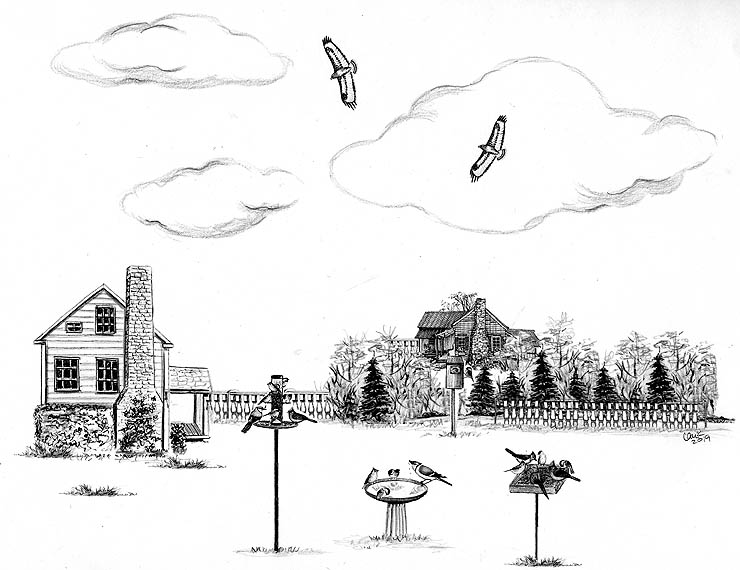
Dear Bird Folks,
For the last few weeks there has been a pair of Red-tailed Hawks calling and circling above my yard. Could they be after the birds on my feeder?
– Ellie, Sandwich, MA
Probably not, Ellie,
There are several species of hawks that can be a problem for feeder birds, but Red-tailed Hawks aren’t one of them. It’s not that red-tails wouldn’t like to eat one of your delicious cardinals or goldfinches, but these hawks are simply too fat and too slow to grab a fast-flying songbird. Instead, they focus on ground-dwelling creatures, such as rabbits and squirrels (no cheering). The smaller Sharp-shinned and Cooper’s Hawks are the real threat to feeder birds. They’ll blast through your backyard at high speed, grabbing unsuspecting birds before you (or they) know it. While red-tails will occasionally hunt on the wing, most of the time they locate prey by simply sitting and waiting for something to walk by. Red-tailed Hawks are those plump, barrel-chested birds we see perched along the highway. They’ll often sit stoically, with their heads down, looking as if they’re hungover…not that I would know anything about that.
If red-tails hunt by sitting, why are they suddenly calling and circling above your yard, you ask? It’s all about spring. Right now birds of all shapes and sizes are searching for a partner. How each bird selects a mate depends upon the species. For example, it is thought that female songbirds choose their mates based on singing ability. The best singer is also likely to be the most fit, and thus would also be a good provider for hungry nestlings. This is why spring mornings are filled with the sounds of so many birds. Each male is trying to out-sing its closest rival. And while hawks aren’t good singers, red-tails have a distinctive voice and they make the most of it. Some folks might not realize it, but we’ve all heard the characteristic screech of the Red-tailed Hawk before. Hollywood loves to use the red-tail’s voice as a “call of the wild,” even if the bird on the screen is an eagle. Moviemakers decided that the voice of the Bald Eagle didn’t fit the majestic bird’s image, so they hire Red-tails to do voice-overs, and the hawks are glad to do it. They need the work.
In late winter, a male red-tail is often seen soaring and screeching high above its territory. If he spots an intruding male, the resident hawk will dive down with his talons extended, ready for action. The trespasser will sometimes flip over, showing its own talons. This process may repeat itself several times before the new kid on the block takes the hint and moves on. Strangely, this territorial defense is relatively similar to the red-tail’s courting display, only this time the encounter is far more affable. Once again the male will soar high above his territory, showing off his flight skills with a series of steep dives. An interested female will fly up to meet him, at which time the male will glide just above her, occasionally touching her with his beak or talons. Both birds will now perform a dramatic series of crisscrossing circles and dives, like a pair of WWI biplanes engaged in an intense aerial dogfight. This brings up the question: Why is it called a “dogfight”? Shouldn’t it be called a “hawk fight”? Dogs don’t even fly. Oh, maybe it’s because of Snoopy and his battles with the Red Baron. Now I get it.
Red-tailed Hawks are extremely active and visible in the spring, Ellie. The pair you are seeing flying above your yard probably have been together for years and are simply renewing their vows. Soon they’ll get down to the business of building a nest and raising a family. And while red-tails are capable predators, they don’t really have the skills needed to pursue little songbirds. In other words, your feeder birds are safe…at least from these hawks. Your squirrels, on the other hand, may want to think about investing in life insurance.
Speaking of nesting:
A few weeks ago I reported evidence (and wishful thinking) that suggested I had screech-owls nesting in a box in my backyard. To quickly refresh everyone’s memory: I have two boxes, one containing a red morph screech-owl (presumably the female) and a second box with a gray morph owl (likely the male). Here’s the update: On the evening of the last full moon, I spent a fair amount of time watching both boxes from inside my house. Things were pretty quiet, until a large owl flew through my backyard and landed in the tree above the male’s box. This was not good. This new owl was not a screecher; instead it was the far deadlier Great Horned Owl. Great horns will eat just about anything they can catch, including screech-owls. Since that night I have not seen signs of either owl. Sigh! Then yesterday afternoon things changed. I set up a spotting scope in my bedroom and from there I could see into the female’s nest box. At first I saw nothing, except the empty black entrance hole. But then the ear tufts of the red owl appeared in the “doorway.” She seemed to be either rotating her eggs or rearranging the furniture, I wasn’t sure. I yelled to my wife to come up to the bedroom right away. There once was a time when a request to come to the bedroom had nothing to do with bird watching. My, how things have changed. Stay tuned.